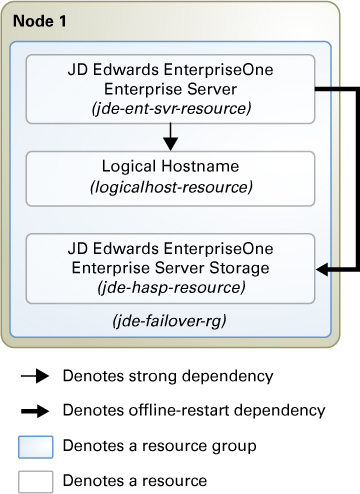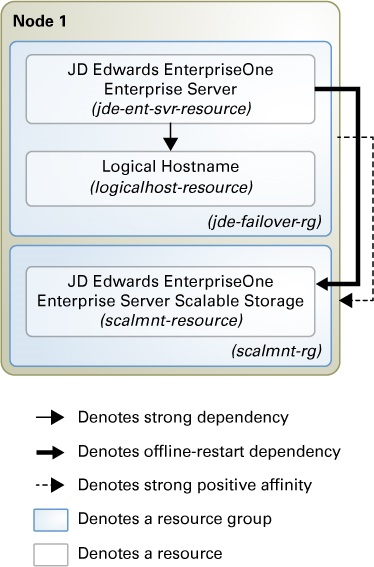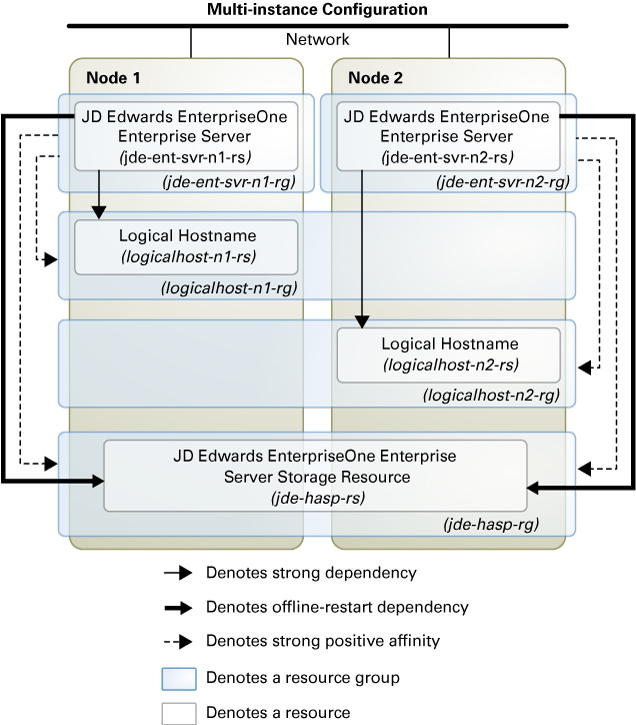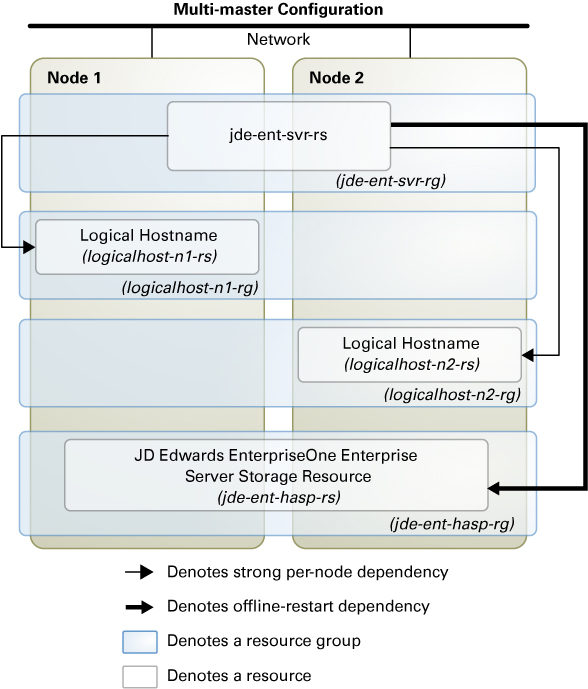Planning the HA for JD Edwards EnterpriseOne Enterprise Server Installation and Configuration
This section contains the following information to plan your JD Edwards EnterpriseOne Enterprise Server installation and configuration:
-
Configuration Restrictions for JD Edwards EnterpriseOne Enterprise Server Software
-
Configuration Requirements for HA for JD Edwards EnterpriseOne Enterprise Server
-
HA for JD Edwards EnterpriseOne Enterprise Server Configurations
Note - Before you begin, consult your JD Edwards EnterpriseOne documentation for configuration restrictions and requirements that are not stated in Oracle Solaris Cluster documentation or imposed by Oracle Solaris Cluster software. Read all JD Edwards EnterpriseOne notes that pertain to your release of JD Edwards EnterpriseOne Enterprise Server. For more information, see the JD Edwards EnterpriseOne documentation.
Configuration Restrictions for JD Edwards EnterpriseOne Enterprise Server Software
The configuration restrictions in the subsections that follow apply only to the JD Edwards EnterpriseOne Enterprise Server.
 | Caution - Your data service configuration might not be supported if you do not observe these restrictions. |
-
Configure the database resource to be in a different resource group than the JD Edwards EnterpriseOne Enterprise Server resource, if possible.
However, if you are using Oracle Database as the database, and if you must configure Oracle Database in the same resource group as the JD Edwards EnterpriseOne Enterprise Server resource, ensure that the value of the Restart_type extension property for Oracle Solaris Cluster HA for Oracle Database is set to RESOURCE_RESTART. This property setting indicates that if the response to a fault in the Oracle database is to restart the Oracle resource, only the Oracle database is restarted. If this property is set to RESOURCE_GROUP_RESTART, and if the response to a fault in the Oracle database is to restart the Oracle resource, all the resources in the resource group are restarted.
-
Ensure that each JD Edwards EnterpriseOne Enterprise Server instance is installed as a different user. If the installation is on a local file system, you can use the same user ID for each instance.
For restrictions that apply to all data services, see the Oracle Solaris Cluster 4.3 Release Notes.
Configuration Requirements for HA for JD Edwards EnterpriseOne Enterprise Server
Follow the requirements in this section to plan the installation and configuration of the JD Edwards EnterpriseOne Enterprise Server. These requirements apply only to the JD Edwards EnterpriseOne Enterprise Server. You must meet these requirements before you proceed with your JD Edwards EnterpriseOne Enterprise Server installation and configuration.
Information about how to install JD Edwards EnterpriseOne Enterprise Server is published at the JD Edwards EnterpriseOne Tools documentation site (http://docs.oracle.com/cd/E17984_01/index.htm). See the Oracle Solaris Cluster 4 Compatibility Guide (http://www.oracle.com/technetwork/server-storage/solaris-cluster/overview/solariscluster4-compatibilityguide-1429037.pdf) for supported versions of JD Edwards EnterpriseOne Enterprise Server.
For requirements that apply to all data services, see Chapter 1, Planning for Oracle Solaris Cluster Data Services in Oracle Solaris Cluster 4.3 Data Services Planning and Administration Guide.
 | Caution - Your data service configuration might not be supported if you do not adhere to these requirements. |
The following configuration requirements apply:
-
UNIX user and group – The UNIX user and group that are used to install, operate, and manage the JD Edwards EnterpriseOne Enterprise Server must exist on all cluster nodes where the corresponding resource for the Enterprise Server is configured to come online. When you run the Oracle Universal Installer, a user is created on that node, for example, jde910. This user starts the application and the user must exist on every cluster node. You can choose to manually create a jde user on every node, or run the installer which creates the user on the node.
-
File systems – The file systems used to store the required binaries and data for the JD Edwards EnterpriseOne Enterprise Server must be configured on highly available local file systems. If you choose to install the binaries on local storage, install and keep them identical on all the cluster nodes. The JDE.INI file must reside on a highly available local file system, which must be accessible where the corresponding resource for the JD Edwards EnterpriseOne Enterprise Server comes online.
If you are setting up the JD Edwards EnterpriseOne Enterprise Server in a multi-instance configuration, a local file system, or a global file system, the Enterprise Server installation should be located on network attached storage (NAS) that is accessible to all nodes running the server.
If you are setting up multiple instances of the JD Edwards EnterpriseOne Enterprise Server in a multi-instance or a multi-master configuration, each instance should be installed as a different user. For JD Edwards EnterpriseOne Enterprise Server version 9.1.x installed through the Platform Pack installer, you can choose to create a user account for the jde910 user. If your configuration is on a local file system, the installation user can be the same for all instances.
-
Logical hostnames – Ensure that the /etc/netmasks file has IP-address subnet and netmask entries for all logical hostnames. If necessary, edit the /etc/netmasks file to add any missing entries.
-
Environment variables – In addition to the required environment variables that are explained in the JD Edwards EnterpriseOne Installation Guide, you must set up some variables after you configure the Enterprise Server. For instructions, see Step 5 of How to Install and Configure JD Edwards EnterpriseOne Enterprise Server Software.
-
Database tier dependency – If the database tier is deployed on the same global cluster, the resource for the JD Edwards EnterpriseOne Enterprise Server must define a strong resource dependency to the resources for the database instance and database listener. This ensures that the JD Edwards EnterpriseOne Enterprise Server will try to start only when the corresponding database is already operational. This configuration is required for a successful startup of the JD Edwards EnterpriseOne Enterprise Server. If the Oracle database is not managed through Oracle Solaris Cluster, you can also configure the database tier dependency by using the data service delivered as part of the Oracle External Proxy resource.
-
Database client network connection – The database client used by the JD Edwards EnterpriseOne Enterprise Server configuration must be configured to connect to the network address that is managed by the cluster framework for the corresponding database server.
-
JDE.INI attribute changes – The following attributes must be changed in the JDE.INI file:
-
Base Datasource should have the logical host resource hostname configured for the JD Edwards EnterpriseOne Enterprise Server resource. For a multiple-master configuration, this is the per-node logical host resource hostname.
For example, the setting in the JDE.INI file looks similar to the following, where LH-rs-hostname is the hostname of the per-node logical host resource:
Base Datasource = LH-rs-hostname – 910 Server Map
-
The listenOnSpecificIP setting in the JDE.INI file must be set to 1:
listenOnSpecificIP=1
-
The SecurityServer attribute under the [SECURITY] section must match the hostname or IP address of the logical host resource configured for the JD Edwards EnterpriseOne Enterprise Server resource. For a multiple-master configuration, this is the per-node logical host resource hostname or IP address.
For example, the setting in the JDE.INI file looks similar to the following, where the IP address of the per-node logical host resource hostname configured for the JD Edwards EnterpriseOne Enterprise Server is 192.1.2.36:
SecurityServer=192.1.2.36
-
The PrimaryNode attribute under the [CLUSTER] section must match the hostname or IP address of the logical host resource configured for the JD Edwards EnterpriseOne Enterprise Server resource. For a multiple-master configuration, this is the per-node logical host resource hostname or IP address.
For example, the setting in the JDE.INI file looks similar to the following, where the IP address of the per-node logical host resource hostname configured for the JD Edwards EnterpriseOne Enterprise Server resource is 192.1.2.36:
PrimaryNode=192.1.2.36
-
HA for JD Edwards EnterpriseOne Enterprise Server Configurations
Use the data service configurations in this section to plan the installation and configuration of the HA for JD Edwards EnterpriseOne Enterprise Server data service.
Failover Configuration
When the HA for JD Edwards EnterpriseOne Enterprise Server software is installed in a traditional file system, a failover deployment requires a configuration where one failover resource group contains the HA for JD Edwards EnterpriseOne Enterprise Server resource, the logical hostname resource, and the failover storage resource. This type of configuration is shown in HA for JD Edwards EnterpriseOne Enterprise Server Configured for Failover with Traditional File Storage.
Figure 1 HA for JD Edwards EnterpriseOne Enterprise Server Configured for Failover with Traditional File Storage

When the HA for JD Edwards EnterpriseOne Enterprise Server software is installed on NAS, a failover resource group is configured with the logical hostname resource and HA for JD Edwards EnterpriseOne Enterprise Server resource. A scalable resource group is configured with the NAS storage resource. This type of configuration is shown in JD Edwards EnterpriseOne Enterprise Server Configured for Failover with NAS.
Figure 2 JD Edwards EnterpriseOne Enterprise Server Configured for Failover with NAS

Multi-Instance Configuration
Multi-instance configuration is an application deployment topology where multiple instances of the same application provide an aggregation of services. This topology can be achieved independently from using a data service because you can manually start and stop the instances on the cluster nodes. When you require high availability of such instances, you can enable a data service for the instances by creating multiple single-node resource groups or a few multi-master resource groups.
HA for JD Edwards EnterpriseOne Enterprise Server Configured as a Multi-Instance Application With Single-Node Resource Groups illustrates a multi-instance configuration using single-node resource groups. A single-node resource group is created for each of the HA for JD Edwards EnterpriseOne Enterprise Server resources. Each resource group has a strong positive affinity on a storage resource group whose primary node contains the HA for JD Edwards EnterpriseOne Enterprise Server resource group.
Each JD Edwards EnterpriseOne Enterprise Server instance runs on each node of the cluster and is managed by a single-node resource group. The suitability is entirely based on the need and environment. As an example use case, a multi-instance configuration can be used when initially there is only one JD Edwards EnterpriseOne Enterprise Server instance in the failover configuration on Node 1 and Node 2, but later there is a need to create another JD Edwards EnterpriseOne Enterprise Server instance.
An easier reconfiguration path would be to reduce the node list of the first Enterprise Server instance resource to Node 1, then create the second server instance in another single-node resource group using Node 2 in the Nodelist property. While doing so, it is also important to ensure that rest of the resources follow the multi-instance configuration described in the following diagram.
Figure 3 HA for JD Edwards EnterpriseOne Enterprise Server Configured as a Multi-Instance Application With Single-Node Resource Groups

Multi-Master Configuration
The multi-master configuration is similar to a multi-instance configuration, except that all the instances of JD Edwards EnterpriseOne Enterprise Server are managed by a single resource. In a multi-master data service configuration, the JD Edwards EnterpriseOne Enterprise Server resource is created in a scalable resource group. The server resource is online on multiple nodes at the same time.
HA for JD Edwards EnterpriseOne Enterprise Server in a Multi-Master Configuration Using a Scalable Resource Group illustrates a multi-master configuration using a scalable resource group. A scalable resource group is created for managing multiple instances of the JD Edwards EnterpriseOne Enterprise Server in a single resource. The resource group has a strong positive affinity on a storage resource group whose primary node contains the JD Edwards EnterpriseOne Enterprise Server resource group.
The suitability is entirely based on the need and environment. If there are multiple JD Edwards EnterpriseOne Enterprise Server instances configured from the beginning, a multi-master configuration can be used to make each instance of Enterprise Server run on each node of the cluster and be managed by a single resource.
Figure 4 HA for JD Edwards EnterpriseOne Enterprise Server in a Multi-Master Configuration Using a Scalable Resource Group
